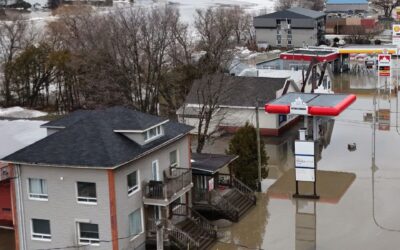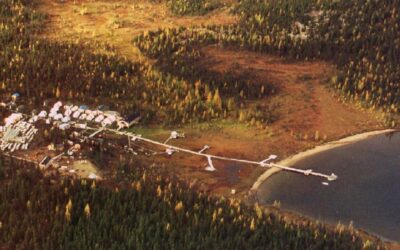Today’s federal throne speech focused first-and-foremost on helping Canadians through the ongoing challenges related to COVID-19. Yet climate change also emerged as a key priority.
Those two themes are separate and distinct, but also have important intersections. All of this leaves a big question: how can the government implement action to deliver on its big ambitions and confront these parallel crises?
Putting health first
Ultimately, this was a COVID-19 speech first, and a climate speech second. At the risk of undermining my climate hawk credibility, that’s OK, and even appropriate.
For those of us who spend most of our days thinking about climate change policy, it’s sometimes easy to forget about the underlying rationale of our work. Climate change isn’t some abstract foe: we should care about climate change and clean growth because it has such big implications for the well-being of Canadians and the Canadian economy.
Yet we can’t address climate change effectively if we’re not managing other threats to our economy and well-being. Tackling COVID-19 is a priority. In that context, taking climate change seriously doesn’t mean shoe-horning every single policy into a climate change frame. Sometimes, two birds require two stones.
Reducing vulnerability
At the same time, there are real overlaps between COVID-19, economic recovery, and tackling climate change. To its credit, the throne speech made some of these connections explicitly—noting the connections between health, well-being, and environmental goals.
COVID-19 and climate change share a common feature: they disproportionately affect vulnerable Canadians. For both climate and COVID-19, some individuals and communities face above-average risks, particularly those that are low-income, Indigenous, racialized, and marginalized. And while vulnerability does not imply weakness, it highlights the fact that some people in Canada have a harder time recovering from shocks like a global pandemic or a changing climate, often due to pre-existing inequities in our society.
As a result, policy efforts that support vulnerable Canadians are crucial. That includes measures named in the throne speech, like investing in affordable housing, ending chronic homelessness, improving infrastructure on Indigenous communities, raising the quality of long-term care, and addressing food insecurity. These measures are essential, not just during COVID times, but also to improve society’s resilience to coming climate change shocks—whether they be extreme weather events or structural changes in the economy.
Kick-starting competitiveness
The throne speech also tackles a second intersection between climate change and economic recovery: it looks to support new economic growth in ways that are consistent with addressing our climate goals.
That’s exactly the focus of our recent report on measuring clean growth. As lead author Rachel Samson notes in the clip below, we need economic growth to support well-being. We also need that new growth to be consistent with Canada’s climate ambitions (for example, net zero by 2050).
How can Canada deliver on that intersection? The commitment to reduce corporate taxes on businesses making net zero products could be a powerful signal, though its ultimate impact will depend on the details.
It could certainly help attract investment and improve Canadian competitiveness in emerging (but important) low-carbon markets. On the other hand, it’s not clear whether it applies to the company or to the activity related to the zero-emission product. What if a firm produces many carbon-intensive products and a single net zero technology? These are important considerations.
Staying the course on climate commitments
Building on last week’s pledge that Ottawa’s climate plan has “not been shelved,” the throne speech went one further. It promised the government would “immediately bring forward a plan to exceed Canada’s 2030 climate goal,” and “legislate Canada’s goal of net-zero emissions by 2050.”
These are not new commitments, but reaffirming them under current circumstances provides certainty—to citizens, businesses, and our international peers—that Canada intends to keep moving forward on these goals. Legislating the 2050 target will help create a connection between action and ambition, especially if it’s accompanied by an accountability framework. Legislating interim milestones—such as the 2030 target, or other five-year goals en route to 2050—could further improve the credibility.
That’s important because managing one crisis while failing to prepare for the next one will not support Canada’s long-term growth and prosperity.
Just take a look at the dizzying array of climate-related events lately. Last week, the West was smoked out by devastating—and climate change-exacerbated—forest fires, a harbinger of some of the threats we face under a changing climate. This week, China committed to Net Zero. California and the UK are banning internal combustion engines sooner than anyone expected. And markets are listening. BP is now forecasting imminent peaking of oil demand in the face of international climate action.
Yet the details will also matter here. Targeted policies mentioned in the speech, such as building retrofit programs, and training and investments to support low-carbon innovation in the energy sector, can contribute to an economic recovery and reduce emissions. But ultimately, to achieve our climate goals, Canada will need some combination of more ambitious regulatory and pricing policies.
That raises questions about what will happen next with Canada’s carbon price (currently under scrutiny at the Supreme Court) and the proposed Clean Fuel Standard. These are undoubtedly challenging priorities to grapple with in the midst of a pandemic and the resulting recession, but further clarity on these and other policy measures is essential to ground Canada’s commitments in demonstrable action.
From vision to implementation
Throne speeches lay out visions, not policy details—and the vision outlined in today’s speech is sweeping. It sets up a mandate to tackle the COVID-19 crisis. To deliver transformational climate change and economic policy in the face of a rapidly changing world. And to tackle fundamental barriers to progress, such as gender inequality, systemic racism, and Indigenous rights and reconciliation.
Yet that ambition is double-edged. Delivering on such a multi-pronged agenda will be a challenging task. Can a minority government juggle multiple—though interconnected—priorities? How will it handle growing concerns around the fiscal resources required to deliver on these ambitions? Can it move past vision to implementation?
We’re about to find out.





